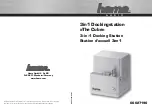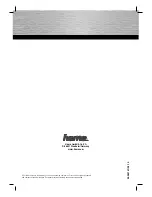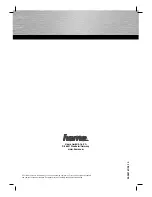
A. LED INDICATOR
• Flashes once when the remote temperature
sensor transmits a reading to the main unit.
• Flashes twice when battery power is low.
B. BATTERY COMPARTMENT
• Holds 2 “AA” batteries
C. RESET
• Resets all readings
D. CHANNEL SWITCH
• Selects the desired channel
E. WALL-MOUNT RECESSED OPENING
• Keeps the remote temperature sensor on
the wall
F. ºF/ºC SELECTOR
• Selects the temperature display in
Fahrenheit or Celsius
BEFORE YOU BEGIN
• We recommend using alkaline batteries
for the remote rain gauge, temperature
sensor and main unit when temperatures
are above 32ºF (0ºC). We recommend
using lithium batteries for the
temperature sensor when temperatures
are below 32ºF (0ºC).
• Avoid using rechargeable batteries.
(Rechargeable batteries cannot maintain
correct power requirements).
• ALWAYS install batteries in the remote
rain gauge and the remote temperature
sensor before the main unit.
• Insert batteries before first use, matching
the polarity in the battery compartment
• Press RESET in the remote temperature
sensor after each battery change with a
paper clip or similar tool.
• Remove protective plastic screen from
LCD display (If any)
• During an initial setup, place the main
unit close to the remote rain gauge and
remote temperature sensor
• Important: Only after reception is
established (the remote rainfall data and
temperature will appear on the main
unit’s display), you may position and
mount the remote sensors (the rain gauge
and the temperature sensor) and the
main unit within the effective
transmission range of 100 feet
(30 meters).
• The remote rain gauge must be placed
outdoors on the open area, away from
the walls, fences and trees and level.
• It is important that excess precipitation
can freely flow from the remote rain
gauge.
• The remote temperature sensor can be
placed indoors or outdoors, depending
on the area where the temperature is
intended to be measured. If you intend
measuring outdoor temperature, place the
remote temperature sensor outdoors.
• The main unit must be placed indoors.
NOTE:
1. Avoid pressing any buttons on the main
unit before the remote rainfall and
temperature data are displayed.
2. The effective operating range may be
influenced by the surrounding building
materials and how the receiver (main
unit) and transmitters (remote rain gauge
and temperature sensor) are positioned.
3. Place the remote rain gauge and
temperature sensor so that it faces
the main unit (receiver), minimizing
obstructions such as doors, walls,
and furniture.
RGR150 manual-FINAL-091908:Layout 1 9/19/08 8:59 AM Page 5






























